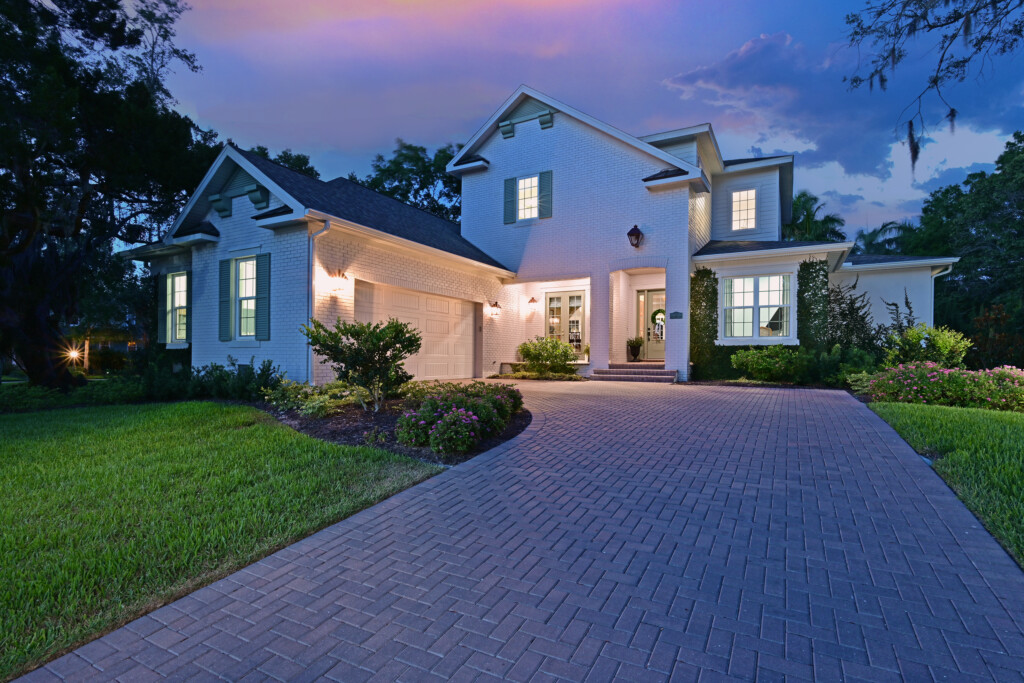When building a custom home in Florida, one of the key decisions you’ll face is determining the number of floors—whether to opt for a single-story or multi-level design. Each option offers distinct advantages and challenges, so it’s important to carefully consider the preferences, needs, and long-term goals of you and your family. Whether you want to optimize a view or ensure accessibility, there are important considerations when deciding between a single story or multi-level home.

- Lot Size and Shape: The size and shape of your property will significantly impact the number of floors you home can have. If you’re working with a smaller lot, building upwards by opting for two or more stories may be the best solution to maximize your living space. In contrast, a larger lot allows for more flexibility in layout, which could make a single-story home more practical and aesthetically pleasing, especially if you want expansive outdoor spaces like a garden or pool.For narrow or irregularly shaped lots, a multi-story design can help optimize space while preserving outdoor areas for leisure, parking, or landscaping.
- Lifestyle and Functionality: The number of floors you choose should align with your lifestyle and functional needs. A single-story or ranch-style home is ideal for those looking for accessibility and convenience. It’s especially beneficial for families with young children, elderly individuals, or anyone with mobility challenges. With all rooms on the same floor, there’s no need to worry about stairs, which can be a major advantage in terms of safety and ease of living.A two-story home offers a balance between space and accessibility. Typically, the living areas, like the kitchen, dining room, and living room, are on the ground floor, while the private areas, such as bedrooms, are located upstairs. This separation can enhance privacy, particularly for families with older children or those who frequently host guests. A two-story design also allows for distinct zoning of living and sleeping spaces, creating a clearer separation between public and private areas.
Three-story homes are more commonly found in urban or coastal areas where maximizing views is a priority. In Florida, a third story might be advantageous for enjoying panoramic Gulf or city views. However, multi-floor homes require more maintenance, including more stairs to navigate and potentially higher energy bills due to the increased square footage.
- Budget Considerations: The cost of construction increases with the number of floors. Building a multi-story home typically requires more materials and labor, resulting in higher upfront costs. The complexity of the design, including stairs, structural reinforcements, and possibly more elaborate foundations, also drives up expenses. Additionally, energy costs may be higher in a multi-story home, as cooling and heating multiple levels can be less efficient than a single-level home.However, if you’re working with a smaller lot, building vertically (with two or three floors) could be more cost-effective than buying a larger piece of land. Similarly, a well-designed two-story home can provide sufficient space while keeping costs lower than a sprawling single-story estate. Always consult with architects and builders to get a realistic estimate of construction costs based on the number of floors you are considering.
- Climate and Weather Conditions: Florida’s hot and humid climate is another crucial factor when deciding on the number of floors. Multi-story homes may require more energy for cooling, especially on the upper floors, which can get warmer. Proper insulation, ventilation, and energy-efficient air conditioning systems are vital in any Florida home, but they are especially important in multi-level homes where temperature control might be trickier.Additionally, Florida is prone to hurricanes and heavy rain, so it’s important to consider how each floor will withstand these conditions. Building to meet local building codes, which are designed to withstand severe weather, is essential regardless of the number of floors. In coastal areas, elevated homes—often with raised foundations—are designed to prevent flooding, and a multi-story design can be particularly helpful in achieving this while maintaining habitable space above flood levels.
- Aesthetic Appeal and Neighborhood Style: The number of floors in your home will also impact its curb appeal and its integration into the surrounding neighborhood. Single-story homes are often considered more traditional and are well-suited to suburban or rural settings. They can evoke a sense of openness and connection to the landscape, which is important in Florida’s coastal and rural areas.Two and three-story homes can offer more architectural complexity and create a more modern or urban aesthetic. In some areas, especially near the coast or in busy urban areas, taller homes may be the norm, and multi-story designs can contribute to a dynamic skyline. Consider the design style you prefer, the views you want to maximize, and how the home will complement the neighborhood’s character.
BW Homes is Your Custom Home Design Partner
Bruce Williams Homes has been working with Sarasota and Bradenton homeowners for over 50 years. We have the knowledge, expertise, and ideas to guarantee that your new home is perfect for your needs.
When building a custom home in Florida, one of the key decisions you’ll face is determining the number of floors—whether to opt for a single-story or multi-level design. Each option offers distinct advantages and challenges, so it’s important to carefully consider the preferences, needs, and long-term goals of you and your family. Whether you want to optimize a view or ensure accessibility, there are important considerations when deciding between a single story or multi-level home.

- Lot Size and Shape: The size and shape of your property will significantly impact the number of floors you home can have. If you’re working with a smaller lot, building upwards by opting for two or more stories may be the best solution to maximize your living space. In contrast, a larger lot allows for more flexibility in layout, which could make a single-story home more practical and aesthetically pleasing, especially if you want expansive outdoor spaces like a garden or pool.For narrow or irregularly shaped lots, a multi-story design can help optimize space while preserving outdoor areas for leisure, parking, or landscaping.
- Lifestyle and Functionality: The number of floors you choose should align with your lifestyle and functional needs. A single-story or ranch-style home is ideal for those looking for accessibility and convenience. It’s especially beneficial for families with young children, elderly individuals, or anyone with mobility challenges. With all rooms on the same floor, there’s no need to worry about stairs, which can be a major advantage in terms of safety and ease of living.A two-story home offers a balance between space and accessibility. Typically, the living areas, like the kitchen, dining room, and living room, are on the ground floor, while the private areas, such as bedrooms, are located upstairs. This separation can enhance privacy, particularly for families with older children or those who frequently host guests. A two-story design also allows for distinct zoning of living and sleeping spaces, creating a clearer separation between public and private areas.
Three-story homes are more commonly found in urban or coastal areas where maximizing views is a priority. In Florida, a third story might be advantageous for enjoying panoramic Gulf or city views. However, multi-floor homes require more maintenance, including more stairs to navigate and potentially higher energy bills due to the increased square footage.
- Budget Considerations: The cost of construction increases with the number of floors. Building a multi-story home typically requires more materials and labor, resulting in higher upfront costs. The complexity of the design, including stairs, structural reinforcements, and possibly more elaborate foundations, also drives up expenses. Additionally, energy costs may be higher in a multi-story home, as cooling and heating multiple levels can be less efficient than a single-level home.However, if you’re working with a smaller lot, building vertically (with two or three floors) could be more cost-effective than buying a larger piece of land. Similarly, a well-designed two-story home can provide sufficient space while keeping costs lower than a sprawling single-story estate. Always consult with architects and builders to get a realistic estimate of construction costs based on the number of floors you are considering.
- Climate and Weather Conditions: Florida’s hot and humid climate is another crucial factor when deciding on the number of floors. Multi-story homes may require more energy for cooling, especially on the upper floors, which can get warmer. Proper insulation, ventilation, and energy-efficient air conditioning systems are vital in any Florida home, but they are especially important in multi-level homes where temperature control might be trickier.Additionally, Florida is prone to hurricanes and heavy rain, so it’s important to consider how each floor will withstand these conditions. Building to meet local building codes, which are designed to withstand severe weather, is essential regardless of the number of floors. In coastal areas, elevated homes—often with raised foundations—are designed to prevent flooding, and a multi-story design can be particularly helpful in achieving this while maintaining habitable space above flood levels.
- Aesthetic Appeal and Neighborhood Style: The number of floors in your home will also impact its curb appeal and its integration into the surrounding neighborhood. Single-story homes are often considered more traditional and are well-suited to suburban or rural settings. They can evoke a sense of openness and connection to the landscape, which is important in Florida’s coastal and rural areas.Two and three-story homes can offer more architectural complexity and create a more modern or urban aesthetic. In some areas, especially near the coast or in busy urban areas, taller homes may be the norm, and multi-story designs can contribute to a dynamic skyline. Consider the design style you prefer, the views you want to maximize, and how the home will complement the neighborhood’s character.
BW Homes is Your Custom Home Design Partner
Bruce Williams Homes has been working with Sarasota and Bradenton homeowners for over 50 years. We have the knowledge, expertise, and ideas to guarantee that your new home is perfect for your needs.






